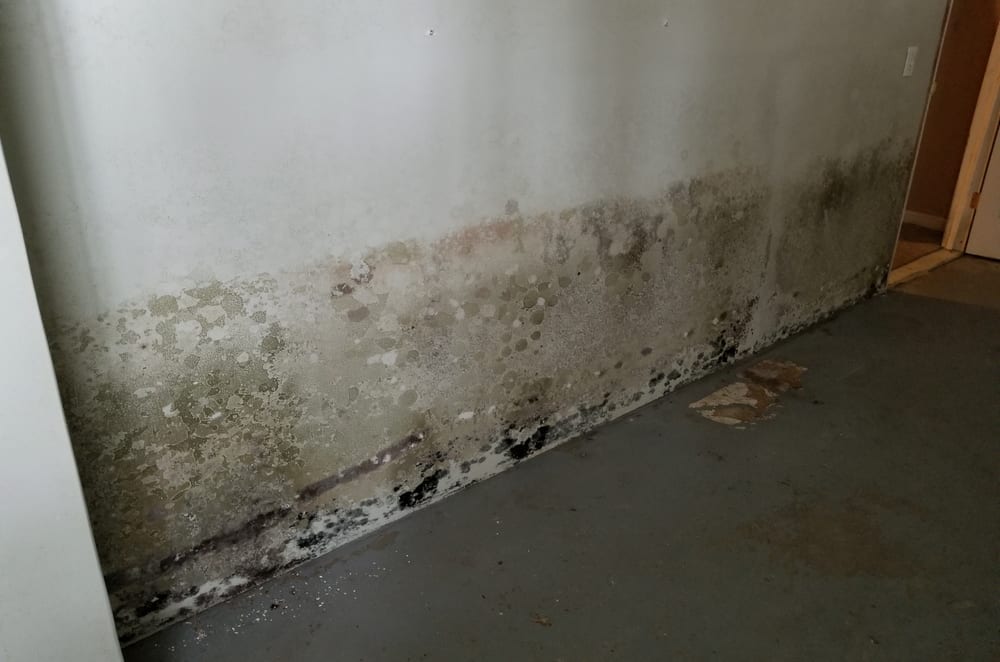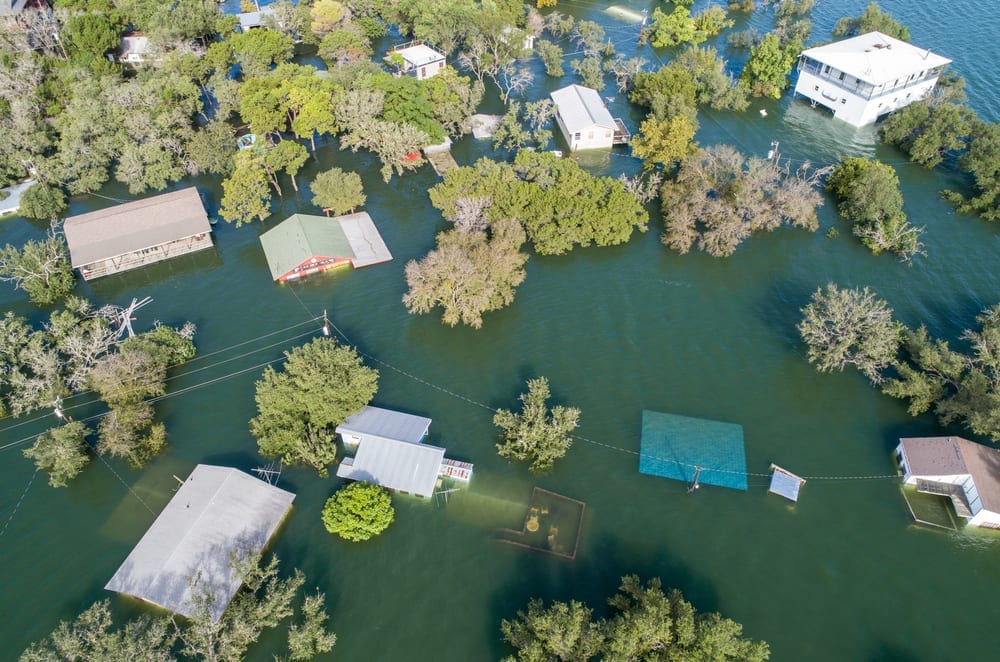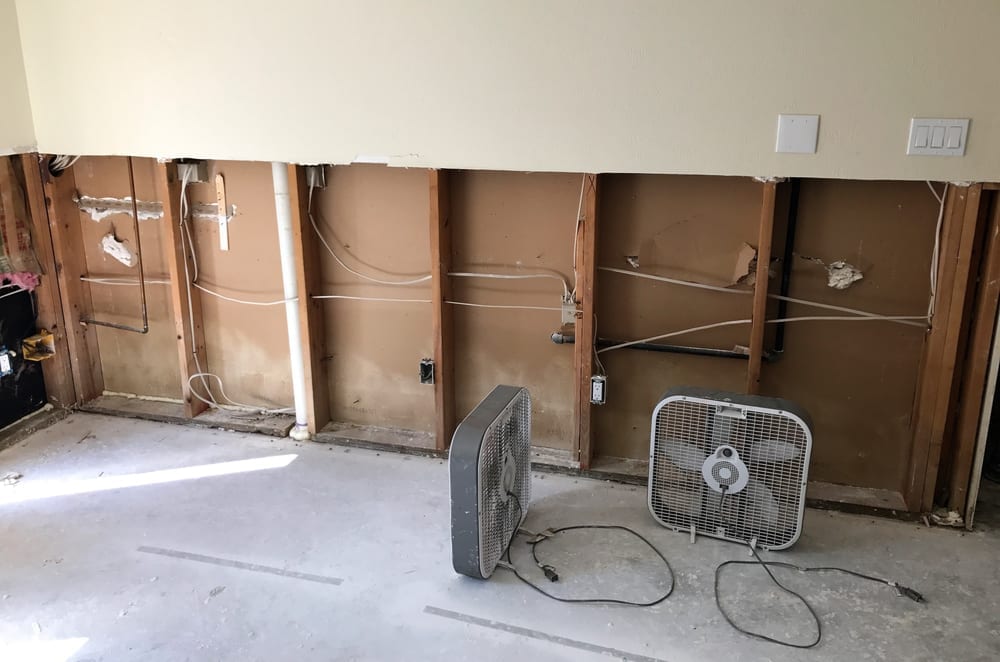Basements are often seen as a great benefit for any home. Unfinished basements provide extra space for storage, while finished basements provide additional living space and enhance property value. Unfortunately, basements are prone to flooding as well. Basements flood for a variety of reasons and they create an expensive mess to clean up. Regardless of whether you have a finished or unfinished basement, cleaning a flooded basement is both time and labor-intensive. Learn how to clean a flooded basement to limit damage and save your possessions.
8 Steps to Cleaning a Flooded Basement
- Identify the Source of the Flooding – Locate and stop the source of the floodwaters to minimize damage and speed cleanup.
- Remove Furniture and Important Items – Save as many personal items from floodwaters as possible.
- Extract Standing Water – Extract floodwaters from your basement using mops, buckets, or pumps.
- Remove Damaged Materials – Remove materials and items that are damaged and cannot be dried or saved.
- Vacuum Out Remaining Water – Use a wet-dry shop-style vacuum to remove the remaining floodwaters.
- Dry Out Your Flooded Basement – Dry your flooded basement with fans and dehumidifiers to stop the water damage.
- Clean and Disinfect to Treat Against for Mold – Clean and disinfect with detergents and sanitizing agents to kill mold, bacteria, and other contaminants.
- Repair the Water Damage – Repair water-damaged materials and surfaces. This can be as simple as painting or as involved as rebuilding walls.
Causes of Basement Flooding
There are many causes of basement flooding, some of the most common include:
- Heavy Rains and Storms – Heavy downpours can result in significant flooding with water entering your basement from the surface, the walls, or the floor.
- Plumbing Malfunctions or Failures – Burst pipes and hot water tank failures can cause basement flooding.
- Clogged Sewer Lines – A clogged or blocked sewer line can result in a sewage backup that floods your home.
- Sump Pump Failure – Whether as a result of a power failure or a clog, your basement or crawlspace will flood if your sump pump stops working.

How to Protect Yourself Before Cleaning a Flooded Basement
It is important to take immediate action if your basement floods to limit damage and increase the chances of saving most items. However, before you start cleaning a flooded basement you should take steps to ensure your safety.
Floodwaters can contain mold, bacteria, parasites, and other contaminants. Always wear tall rubber boots, pants, long sleeves, rubber gloves, and goggles when cleaning a flooded basement. Waders are optional but recommended. If the water has sat for longer than 24 hours or it contains sewage, you should also wear a ventilator that covers your mouth and nose.
Water and electricity are a dangerous mix and you should turn off the electricity to your basement if the water level is within 2 inches of electrical outlets. Never enter floodwaters if they are near or over electrical outlets.
How to Clean a Flooded Basement
1. Identify the Source of the Water
Before cleaning a flooded basement, you need to know where the water is coming from. If the flood is a result of a plumbing leak or burst pipe, turn off your main water shutoff valve to stop the flow of water.
For sump pump failures, try to restore power or use a manual or battery backup pump. In the event of a sewage backup or groundwater flooding, you may not be able to resolve the issue but should begin cleaning your flooded basement immediately to reduce damage.
2. Remove Furniture and Important Items
If possible, you should remove furniture and important or valuable personal items before beginning cleanup. The sooner you remove furniture, the better your chance of saving the item. Store wet furniture in a cool, dry place until you can properly dry and disinfect the items.
Also, remove personal items including documents, valuables, artwork, antiques, and heirlooms. Put important papers and documents in the freezer to dry. Put valuables, artwork, and heirlooms in a cool, dry place.
If necessary, use a tarp or heavy-duty plastic trash bags to prevent them from damaging other surfaces. Never attempt to clean or restore jewelry, artwork, antiques, or heirlooms by yourself. Instead, consult a professional.
3. Extract Standing Water
Begin cleaning a flooded basement by removing the standing water. If the water is less than a few inches, use a mop or towels to soak up water. Wring saturated materials out in buckets and then dump them outside, away from your home. Avoid pouring water down your drains, as this can cause more flooding or even result in a sewage backup.
If there are more than a few inches, you should either bale out the water using a bucket or use a pump. When bailing out a flooded basement, use as many buckets or containers as possible. Consider forming a line of people or a bucket brigade to remove standing water as quickly as possible.
When using a manual or powered pump, make sure it has a long drainage hose. Position the outlet of the hose as far away from your foundation as possible to limit the chances of the water re-entering your basement. Otherwise, pump the water into a bucket and dump it outside, away from your home.
Follow the manufacturers’ instructions on powered pumps, paying special attention to run times to avoid overheating or damaging the unit. Pumps are available for rent from most local equipment supply stores and some hardware stores.
4. Remove Damaged Materials
Unfortunately, not every item involved in a basement flood is salvageable. Some items will need to be thrown away. Use heavy-duty garbage bags to collect water-damaged items. The amount of items you need to throw away depends on the type of water involved and the extent of the damage.
If you aren’t ready to put in the effort to dry and clean the item or it is easily replaceable, its best to dispose of it now. The more items you can remove from the area, the faster and easier it will be to dry. While it can be difficult to let go of some possessions, they pose a risk of developing mold if not treated quickly.
This also goes for water-damaged building materials as well. If the drywall is saturated, warped, cracking, or crumbling, cut it out a few inches above the waterline. Remove wooden furniture and cabinets, especially items made from composite or laminate wood materials, that are warped, swollen, or falling apart.
If the flood was a result of clean water, you can usually dry and clean carpeting. However, if it was a groundwater flood or sewage backup, its best to dispose of the carpeting. Carpet padding should always be thrown away, as it’s nearly impossible to clean and disinfect.
5. Vacuum Out Remaining Water
Whether you pumped, bailed, or mopped out the floodwaters, there is still a significant amount of moisture in your basement. Carpeting, drywall, cabinets, and other materials absorbed at least some water. Removing that water is critical to speed up the drying process.
Use a wet-dry vacuum, also known as a shop vac, to extract the remaining water from flood-damaged surfaces. Start working on the highest areas and move down to prevent materials from dripping or seeping onto lower items.
Work in small sections, moving the vacuum in multiple directions to ensure the best extraction Vacuum every wet surface, leaving it is just barely damp to the touch. Empty the shop vac canister as necessary, making sure to dump the water outside and away from your property.
Depending on the material involved and your model of shop vac, you may need to vacuum items multiple times. If you don’t have a wet-dry vacuum, you can rent one from your local equipment supply company or some hardware stores.
6. Dry Out Your Flooded Basement
Now that you have removed as much water as possible, begin drying a flooded basement using fans and dehumidifiers. Consumer-grade fans and dehumidifiers aren’t designed for drying out after a flood, so they will take much longer than commercial grade equipment.
Commercial fans, also known as air movers, and dehumidifiers are available for rent at your local equipment rental company as well as some hardware stores. Depending on the extent of the damage and the amount of equipment you have, it may be worth it or even necessary to rent additional items.
Regardless of the equipment you use, place items throughout the flooded area to promote airflow and facilitate drying. Check surfaces every few hours and reposition equipment as necessary. Depending on the materials involved and the size of the space damaged in the flood, it may take as little as few hours and as long as several days to dry out completely.
You can dry most structural materials like wooden wall studs, drywall, and cabinets in place. However, you should remove wet carpeting and dry it in another location. For complete carpet drying instructions, review our drying water-damaged carpeting guide.
7. Clean and Disinfect to Treat Against for Mold
Floodwaters can leave behind a significant amount of dirt and debris, as well as mold, bacteria, parasites, and other contaminants. Use a shop vac to remove dirt and debris left behind by floodwater.
Mold is a symptom of a persistent source of moisture. Depending on the type of water involved in the flood and the amount of time it took to dry out, it’s possible for mold to grow.
For clean water from a water supply line problem, mold can grow in as little as 48 to 72 hours. If the flood involved groundwater or sewage, mold growth is possible in as little as 24 hours. Bacteria and parasites are commonly found in groundwater and sewage but can develop in clean water in as little as 24 to 48 hours.
To treat against these contaminants both now and in the future, begin by cleaning with a mild detergent in warm water. Use a rag or sponge to clean all the surfaces and items affected by the floor. Use a clean towel to dry items after cleaning.
Then use a hospital-grade disinfectant to sanitize after a flood. Apply it with a spray bottle or other type of spray dispenser to ensure an even coat. While a solution of bleach and water is effective at treating mold and other contaminants, chlorine bleach can stain carpeting, upholstery, and other fabrics.
Review our drying carpeting guide and drying a wet mattress guide for instructions on cleaning and disinfecting those items.
8. Repair the Water Damage
After cleaning and drying a flooded basement, you may need to make repairs to structural damage. Every flood is different, so the type of repairs necessary will vary. Depending on the specific damage involved, you may need to hang new drywall, install new flooring, or replace cabinets and countertops. In other cases, you may be able to just paint walls or refinish wood surfaces.
How to Handle Electronics After a Flood
Aside from furniture, electronics are usually the most expensive item that is damaged in a flood. While most of us are reluctant to dispose of electronics, water and electricity are a dangerous combination.
Be careful when using electronics in a flooded basement. Not only can the flood damage these items, but they are very difficult to dry out. This can lead to mold growing on or even inside them.
Electronics damaged in a clean water flood should be inspected by a repair technician before use. You should dispose of any electronic item involved in a sewage backup, as they are nearly impossible to clean and disinfect.
How to File an Insurance Claim After a Flooded Basement
You should always document flood damage, as well as the cleanup and dry out process, for potential insurance claims. Keep receipts for all items used in the flood cleanup. This includes equipment rents, protective gear like gloves and ventilators, and cleaners and disinfecting chemicals.
Unfortunately, not all flood damage is covered by insurance. Most standard insurance policies will not cover groundwater flooding. Review your insurance policy for complete details about your coverage. Contact your agent if you have any questions.
Call Now For a Free Estimate on Flooded Basement Cleanout Services
If you have a flooded basement, our restoration specialists are here to clean up and repair the damage quickly. Call 1-888-443-3110 now for a free estimate on flood damage restoration.






